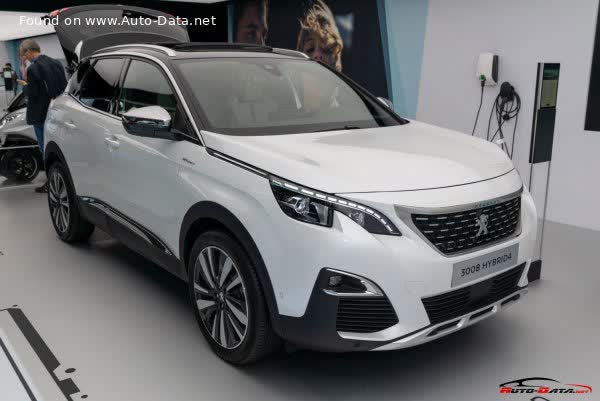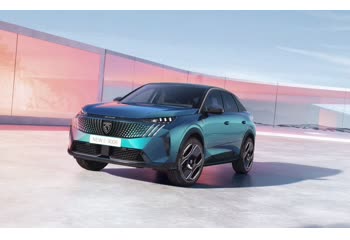Everything you need to know about specifications and performance - Peugeot 3008 2016 - 1.6 BlueHDi (100 Hp) S&S

Overview:
What is the engine capacity of a Peugeot 3008 2016?
The engine capacity of the Peugeot 3008 2016 is 1560.
Peugeot 3008 2016 How many horsepower?
The engine power of the Peugeot 3008 2016 is 100 Hp @ 3750 rpm..
What is the Peugeot 3008 2016 engine?
Peugeot 3008 2016 engine is BHY DV6FD. (Click to see other cars using the same engine)
How much gasoline does a Peugeot 3008 2016 consume?
The Peugeot 3008 2016 consumes 4.0-4.2 liters of gasoline per 100 km
General:
Brand: Peugeot
Model: 3008
Generation: II (Phase I, 2016)
Modification (Engine): 1.6 BlueHDi (100 Hp) S&S
Start of production: 2016
End of production: 2018
Powertrain Architecture: Internal Combustion Engine
Body type:Sports Utility Vehicle (SUV)
Seats: 5
Doors: 5
Engine:
Engine systems: Start & Stop System
Power: 100 hp @ 3750 rpm.
Power per litre: 64.1 hp/l
Torque: 254 nm @ 1750 rpm.
Engine Model/Code:BHY DV6FD
Engine displacement: 1560
Number of cylinders: 4
Engine configuration: Inline
Number of valves per cylinder: 2
Fuel injection system: Diesel Commonrail
Engine aspiration: Turbocharger, Intercooler
Engine oil capacity: 3.75 l
Engine layout: Front, Transverse
Cylinder Bore: 75 mm
Piston Stroke: 88.3 mm
Performance:
Fuel Type: Diesel
Fuel consumption (economy) - urban: 4.2-4.5 l/100 km
Fuel consumption (economy) - extra urban: 3.8-4.1 l/100 km
Fuel consumption (economy) - combined: 4.0-4.2 l/100 km
Emission standard: Euro 6
Acceleration 0 - 100 km/h: 13.1 sec
Acceleration 0 - 62 mph: 13.1 sec
Maximum speed: 174 km/h
Weight-to-power ratio: 12.9 kg/Hp, 77.5 Hp/tonne
Weight-to-torque ratio: 5.1 kg/Nm, 196.9 Nm/tonne
Acceleration 0 - 60 mph: 12.4 sec
Space:
Kerb Weight (kg): 1290
Max. weight (kg): 1940
Max load (kg): 650
Trunk (boot) space - maximum: 1482 l
Trunk (boot) space - minimum: 520 l
Permitted trailer load with brakes (12%): 1300 kg
Fuel tank capacity: 53 l
dimensions:
Length: 4447 mm
Width: 1841 mm
Height: 1615 mm
wheelbase: 2675 mm
Width with mirrors folded: 1906 mm
Width including mirrors: 2098 mm
Front track: 1579-1601 mm
Rear (Back) track: 1587-1610 mm
Front overhang: 923 mm
Rear overhang: 849 mm
Ride height (ground clearance): 219 mm
Minimum turning circle (turning diameter): 10.67 m
Approach angle: 20°
Departure angle: 29°
Powertrain, Suspension and Brakes:
Drivetrain Architecture: The Internal combustion Engine (ICE) drives the front wheels of the vehicle.
Drive wheel: Front wheel drive
Number of gears and type of gearbox: 5 gears, manual transmission
Front brakes: Ventilated discs
Rear brakes: Disc
Assisting systems: ABS (Anti-lock braking system)
Steering type: Steering rack and pinion
Power steering: Electric Steering
Tires size: 215/65 R17; 225/55 R18; 205/55 R19
Wheel rims size: 17; 18; 19
Front suspension: Independent, type McPherson with coil Spring and anti-roll bar
Rear suspension: Semi-independent, coil Spring
See also

Last generation.
Its production began in 2023 until Now

Same engine. (BHY DV6FD).
Its production began in 2017 until 2018

Same engine. (BHY DV6FD).
Its production began in 2015 until 2017

Same production year and almost the same engine capacity.
Its production began in 2016 until 2021

Write a comment